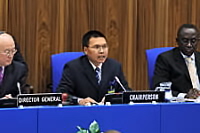Iran is still not providing the International Atomic Energy Agency (IAEA) with the necessary cooperation to confirm that its nuclear activities are purely peaceful. Nor has Syria enabled the agency to resolve issues relating to sites where uranium particles have been found.
 |
| The IAEA board meeting will be the first for newly elected chairman Dato' Muhammad Shahrul Ikram Yaakob (Image: IAEA) |
The latest IAEA safeguards reports on Iran and Syria have been published by the US-based Institute for Science and International Security (ISIS) in advance of the next meeting of the Agency's board of governors, which will take place on 1 March.
The IAEA continues to verify the non-diversion of declared nuclear material in Iran, but has once again criticised Iran for failing to cooperate fully to enable the Agency to confirm that all of its nuclear material is in use for peaceful activities and has even gone so far as to raise concerns about possible military activities. Although the information available to the IAEA is "broadly consistent and credible" in terms of technical detail, timeframes and details of personnel and organizations involved, the Agency report is direct: "Altogether, this raises concerns about the possible existence in Iran of past or current undisclosed activities related to the development of a nuclear payload for a missile", it says.
The 10-page document on Iran verifies that as of 22 November 2009 a total of 1808 kg of uranium enriched to 3.47% U-235 had been produced at the Fuel Enrichment Plant (FEP) at Natanz. With Iran estimating that a further 257 kg of low enriched uranium had been produced between 23 November 2009 and 29 January 2010, this means the plant, which is subject to IAEA safeguards, has produced a total of 2065 kg of low enriched uranium.
Iran recently announced to the IAEA its plans to increase enrichment levels at its Pilot Fuel Enrichment Plant (PFEP) to up to 20% enrichment, a level still formally classified as low enrichment and sufficient, theoretically, to make fuel for Tehran's research reactor, which produces medical imaging isotopes. Iran has provided the IAEA with mass spectrometry results which indicate that enrichment levels of up to 19.8% U-235 were obtained at PFEP earlier this month, and IAEA inspectors have subsequently witnessed the transfer of some 1950 kg of low enriched UF6 from FEP to the PFEP feed station.
However, the IAEA says that the period of notice provided by Iran was insufficient for it to adjust the existing safeguards procedures at the plant before Iran started feeding low-enriched uranium into the PFEP line. Now, the Agency says, additional measures need to be put in place to ensure the its continuing ability to verify the non-diversion of the nuclear material at PFEP.
Khameini: no bombs
According to ISIS, the IAEA's language suggests the Agency is concerned that Iran is currently working on developing a nuclear warhead. However, Iran's Supreme Leader Ayatollah Khamenei said that the country has no interest in nuclear weapons, considering them forbidden under Islam. "We do not have the least belief in gaining nuclear arms," state news agency IRNA reported the Ayatollah as saying at the launch of a new warship.
Syrian sites still unconfirmed
The IAEA safeguards report on Syria notes that the country has still not provided sufficient information for the IAEA to confirm its assertions that an installation at Dair Alzour, destroyed by an Israeli air strike in September 2007, was indeed a military non-nuclear installation and not a clandestine nuclear reactor site. Samples collected from the site in June 2008 revealed the presence of anthropogenic natural uranium (natural uranium which has been chemically processed), which Syria maintains came from the missiles used to destroy the building. "In this context, information yet to be provided by Israel might be helpful in clarifying the matter", the agency hints.
The report also notes that Syria's initial explanations for anthropogenic natural uranium particles found at another site, the Miniature Neutron Source Reactor (MNSR), have also not been supported by subsequent sampling carried out by the IAEA.
The presence of the uranium at the two sites is cause for concern, the Agency suggests. "Given that Syria has no reported inventory of natural uranium, this calls into question the completeness and correctness of Syria's declarations concerning nuclear material and facilities," the report notes, adding "The Director General urges Syria to engage with the Agency on the above issues so that ... the Agency is able to confirm that all nuclear material in Syria is in peaceful activities."
Researched and written
by World Nuclear News




_18570.jpg)
_18938.jpg)
_33584.jpg)
_82983.jpg)





